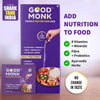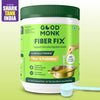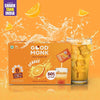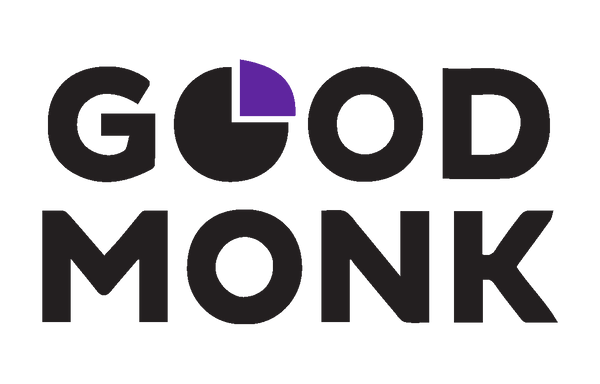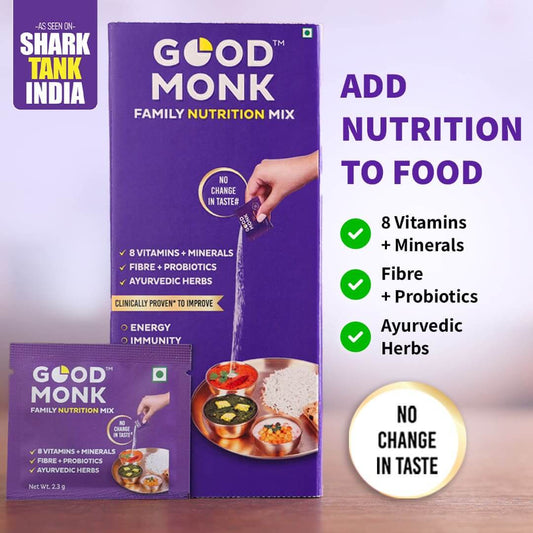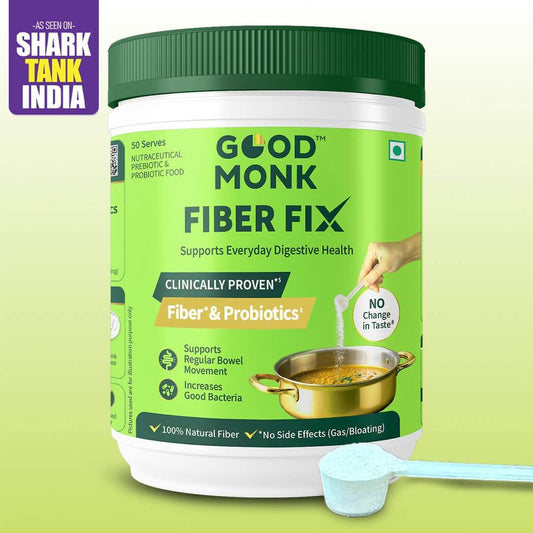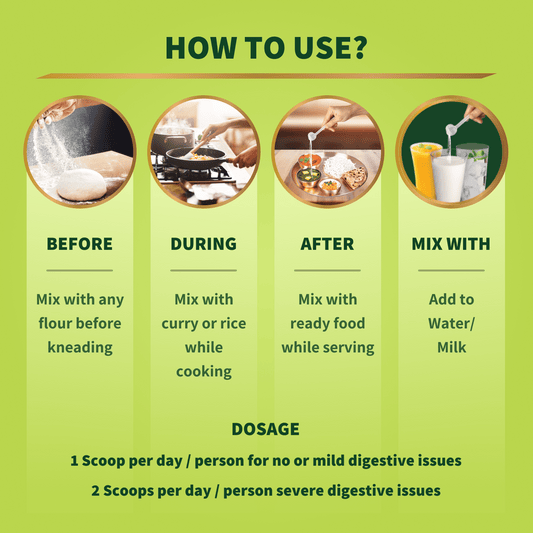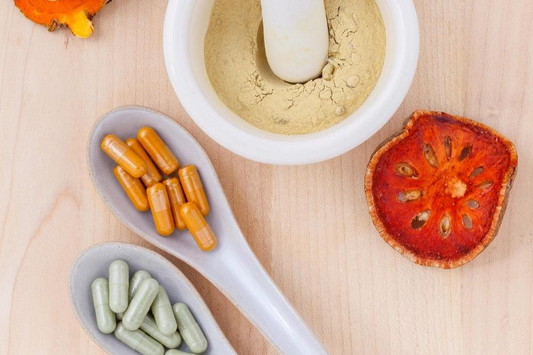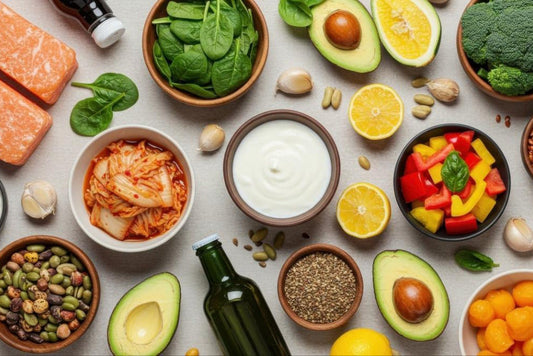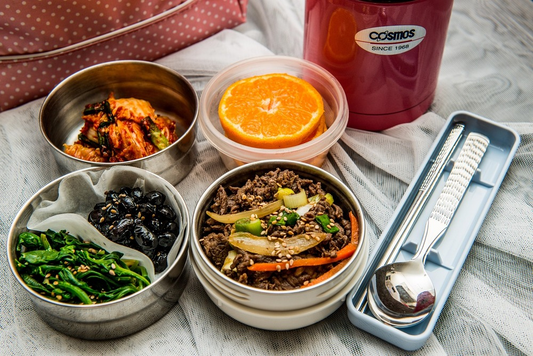Are you feeling low on energy or tired all of a sudden? What is the reason behind the sudden tiredness? Your low haemoglobin levels are the culprit!
Haemoglobin is responsible for carrying oxygen throughout your body, and it is essential to maintain healthy levels for your overall well-being. In this article, Good Monk will guide you on how to naturally raise your haemoglobin and why you should focus on your diet and nutritional levels.
Learn how to increase hb with 10 iron-rich foods and support your journey to better health and vitality.
What Is Haemoglobin?
Haemoglobin is a vital protein that is mainly found in red blood cells. It performs the function of carrying oxygen from the lungs to various tissues of our body, and transports carbon dioxide back to the lungs for exhalation.
Haemoglobin gives the red colour to the blood present in our body and plays an important role in maintaining healthy body function and energy levels.
What Is Normal Haemoglobin Range?
Normal haemoglobin levels vary based on age and sex of the individual. The following chart will help you understand better.
|
Group |
Normal Haemoglobin Levels (g/dL) |
|
Adult Men |
13.5-18 |
|
Adult Women |
12-16 |
|
Children (6-18) |
10-15.5 |
|
Newborns |
14-24 |
Signs of Low Haemoglobin
The signs of low haemoglobin levels [1] include:
- General weakness
- Pale or yellowish skin
- Persistent fatigue or tiredness
- Irregular or rapid heartbeat
- Shortness of breath, especially during physical activities
- Headaches
- Lightheadedness or dizziness
- Cold feet and hands
- Hair loss or brittle nails
- Chest pain in severe cases
- Unusual cravings for non-food items (pica)
- Inflamed or sore tongue
- Difficulty concentrating or thinking clearly
- Poor appetite, especially in children
Top 10 Iron-Rich Foods to Boost Haemoglobin
If you want to increase your iron intake with a dietary change and raise hemoglobin naturally, here are the iron-rich foods you should try out.
1. Spinach (Palak)
Spinach is among the leafy green, iron-rich vegetables. Though it is less easily absorbed than heme iron, spinach's iron is still a great dietary source. About 36% of the daily recommended intake for women, one cup of cooked spinach has roughly 6.4 mg of iron. Additionally, high in vitamin C, spinach can help improve the absorption of non-heme iron taken concurrently. It also makes a natural fiber drink.
2. Meat from the Liver and other organ meats
Liver and organ meats are amazing, iron-rich foods. Chicken liver, for example, offers roughly 9 mg of iron per 100 gram serving, exceeding daily iron needs. Organ meats also provide several other minerals, including copper, folate, vitamin B12, and vitamin A.
3. Legumes - (Dal, Chana, Rajma, Moong etc)
Excellent foods to increase haemoglobin include legumes, including lentils, chickpeas, black beans, and peas. For instance, a cup of cooked lentils has roughly 6.6 mg of iron, about 37% of the daily recommended intake. Legumes are common in Indian diets and contain high protein, fibre, and vital micronutrients, including folate, magnesium, and potassium.
4. Red meat
Iron is mainly found in red meat, beef, lamb, pork, etc. About 3.2 mg of iron, which is about 18% of the daily recommended intake for women, is found in 100 grams serving of cooked red meat. Red meat provides high-quality protein, vitamin B12, and zinc—all vital for muscle development, nerve function, and immunity.
5. Pumpkin Seeds
A healthy iron-rich food with reasonable non-heme iron content is pumpkin seeds. About 8.8 mg of iron is found in 100 grams of pumpkin seeds, or roughly 49% of the daily recommended intake for women. Rich in magnesium, zinc, and good fats as well, these iron-rich vegetable seeds support the immune system, heart, and bone health. Including pumpkin seeds in your diet can be as easy as tossing them over oatmeal, yoghurt, or salads or as a crunchy snack.
6. Dark chocolate
Apart from being a great treat, dark chocolate high in cocoa content is a good source of non-heme iron. About 11.8 mg of iron, roughly 65% of the daily advised intake for women, comes from 100 grams of dark chocolate (70–85% cocoa). Antioxidants also abound in dark chocolate, including flavonoids, which can help with heart health and inflammation reduction. Introduce a chocolate-flavoured milk mix powder to your kids for extra benefits.
7. Fish
Heme iron is plentiful in some fish, including mackerel, salmon, and tuna. About 4.7 mg of iron, roughly 8% of the daily recommended intake for women, can be extracted from a 100 gram serving of fish. Fish is an excellent source of iron and omega-3 fatty acids.
8. Sardines
Don’t go by their size as these small fish [2] are rich in heme iron and omege-3 fatty acids. The nutrients support both haemoglobin and heart health. The taste of these Hb improving foods makes them an enjoyable way to improve hemoglobin levels.
9. Pomegranate
Pomegranate fruit can be consumed daily and is rich in fibre, iron, calcium and antioxidants. Regular consumption of this food to raise rbc helps increase the haemoglobin levels in your body and promote healthy blood flow [3].
10. Millets (Bajra, Jowar, Ragi)
Millets are traditional Indian grains high in Iron and fiber. 100 grams of cooked millet can provide around 3mg of Iron. Include this iron rich food in your daily diet to improve hemoglobin levels naturally.
Top 10 Iron-Rich Food Chart
Here is a top 10 Iron-rich food chart with blood increasing foods list and their iron content per 100 grams to help you decide on a haemoglobin-rich diet.
|
Iron-rich food |
Iron Content in mg per 100 g |
|
Liver |
6.5-12.9 mg |
|
Dark Chocolate (70-85% cocoa) |
11.8 mg |
|
Red Meat |
3.2 mg |
|
Pumpkin Seeds |
8.8 mg |
|
Fish (Tuna, Salmon, Mackerel) |
4.7 mg |
|
Spinach (Cooked) |
3.6 mg |
|
Legumes (Lentils) |
3.3 mg (cooked lentils) |
|
Sardines |
2.9 mg |
|
Milelts |
3 mg |
|
Pomegranate |
0.3 mg |
In addition to these foods, adding a nutrition drink powder into your daily routine can provide a convenient and effective way to increase iron intake and boost your hemoglobin levels
Daily Iron Requirements by Age and Gender
|
Group |
Recommended Daily Intake |
|
Infants (0–6 months) |
0.27 mg |
|
Children (1–8 years) |
7–10 mg |
|
Women (19–50 years) |
18 mg |
|
Men (19–50 years) |
8 mg |
|
Pregnant Women |
27 mg |
After 50, a health mix for senior citizens that is rich in iron, B vitamins and other essential nutrients can help support healthy hemoglobin levels.
Importance Of Iron For Haemoglobin
The importance of iron-rich foods to increase haemoglobin includes:
- Iron-rich foods are essential to haemoglobin, the protein in red blood cells that transports oxygen from the lungs.
- Maintaining energy levels requires adequate iron levels to transport oxygen.
- Iron helps immune cells grow and differentiate, supporting the immune system.
- Cognitive development, especially in infants and young children, requires iron.
- Normal iron levels facilitate muscle endurance and function.
- Foods that contain high iron hel.p tissues grow and repair by synthesising DNA and dividing cells.
Maintaining adequate levels of vitamins and minerals is essential for hemoglobin production. Good Monk’s multivitamin with probiotic can support your overall health.
Final Thoughts on Iron-Rich Foods
Maintaining general health and raising haemoglobin levels depend on including a range of foods from the iron-rich foods list in your diet. From shellfish and red meat to leafy greens and legumes, there is a wide range of vegetables high in iron and iron-rich fruits. If you're wondering how to increase hb levels naturally, try including these foods alongside a balanced health mix.
Make these smart choices today to enjoy the newer version of you that is full of energy and live your life to the fullest. Take charge of your health today- browse through the Good Monk’s products and feel the difference.
If you are looking to support a loved one's health journey, our wellness gift with iron-rich blends and essential nutrients can be a meaningful choice.
FAQs on HB Improving Foods
1. Are there different types of iron in foods?
Indeed, two forms of dietary iron exist: non-heme and heme iron. Meat, fish, and poultry are animal-based foods high in heme iron; the body absorbs this mineral more readily. Found in plant-based foods, including legumes, grains, and vegetables, non-heme iron absorbs less.
2. How can I improve the absorption of iron from my diet?
Eat foods high in vitamin C, such as citrus fruits, tomatoes, and bell peppers, along with iron-rich foods to improve iron absorption.
3. How much iron do I need daily?
Age, gender, and life stage all affect the daily iron requirement. While adult women demand 18 mg daily, adult men usually need around 8 mg of iron.
4. Are there specific conditions that require more iron intake?
The body's demand for iron can be raised by some disorders, including pregnancy, menstruation, and chronic diseases. Particularly pregnant women need more iron to support the growth of the foetus and increase blood volume.
5. Which fruit has high iron?
Some iron-rich fruits include watermelon, raisins, dates, prunes, and strawberries.
6. Can iron supplements replace food sources?
Iron supplements help treat iron deficiency. However, they cannot fully replace the nutritional benefits and nutrient synergy that you will receive from iron-rich foods.
7. How long does it take to increase haemoglobin through diet?
It typically takes 2 to 4 weeks to increase haemoglobin through dietary supplements. However, it might take up to a month or more to witness noticeable improvements. It all depends on the severity of the deficiency and individual absorption rates.
8. How to improve haemoglobin naturally?
Consume iron-rich foods, including Vitamin C for better absorption, consume vitamin B12 sources and folate, and avoid coffee and tea. Lastly, include calcium with iron-rich foods, exercise regularly, and stay hydrated.
9. Can hypertension cause low haemoglobin?
Yes, low haemoglobin levels are associated with hypertension. It is usually associated with cases where there are instances of kidney impairment, uncontrolled high blood pressure, or increased inflammation.
10. Does fish oil have iron?
No, fish oil does not contain iron.
References:
[1] https://www.mayoclinic.org/diseases-conditions/iron-deficiency-anemia/symptoms-causes/syc-20355034
[2] https://draxe.com/nutrition/iron-rich-foods/
[3] https://www.medicinenet.com/how_do_i_increase_my_hemoglobin/article.htm
Related articles:
Iron supplements to boost women’s health
Nutrition-rich foods to include in your diet
Difference between vitamins and minerals
About the Author
Written by the team at Good Monk—a clean and honest nutrition brand supported by doctors and food scientists. Every product is backed by clinical studies and made to help families eat better, feel better, and live healthier every day.
Popular Searches
Health Mix | Health Drink For Senior Citizens | Milk Mix Powder | Pineapple Powder | Family Health Nutrition Combo | Fiber Supplements India | Fruit Powder
